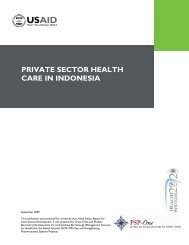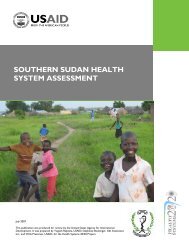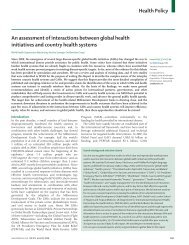Case Study on Piloting Complex Health Reforms in ... - PHRplus
Case Study on Piloting Complex Health Reforms in ... - PHRplus
Case Study on Piloting Complex Health Reforms in ... - PHRplus
You also want an ePaper? Increase the reach of your titles
YUMPU automatically turns print PDFs into web optimized ePapers that Google loves.
<strong>in</strong> a strategic visi<strong>on</strong> and flexible bluepr<strong>in</strong>t for nati<strong>on</strong>al health care reform, effective d<strong>on</strong>or<br />
collaborati<strong>on</strong> mechanisms, and <strong>in</strong>creased capacity am<strong>on</strong>g nati<strong>on</strong>al- and oblast-level health reform<br />
stakeholders.<br />
Development of the MANAS Program took place <strong>in</strong> several phases, <strong>in</strong>clud<strong>in</strong>g situati<strong>on</strong> analysis,<br />
development of strategic policy opti<strong>on</strong>s, and development and ref<strong>in</strong>ement of the details of the<br />
Program. The MANAS Program developed short-, medium-, and l<strong>on</strong>g-term strategies for health care<br />
reform, while improv<strong>in</strong>g managerial capacity <strong>in</strong> the health system at both the nati<strong>on</strong>al and regi<strong>on</strong>al<br />
levels. The plan <strong>in</strong>cluded strategies to rati<strong>on</strong>alize excess capacity <strong>in</strong> the health system and redirect<br />
sav<strong>in</strong>gs to strengthen primary health care. In health f<strong>in</strong>anc<strong>in</strong>g, the plan outl<strong>in</strong>ed strategies to <strong>in</strong>crease<br />
sources of fund<strong>in</strong>g, improve resource allocati<strong>on</strong>, and <strong>in</strong>troduce new provider payment systems. The<br />
MANAS Program planned to reorganize PHC and hospital services, and to better manage and <strong>in</strong>vest<br />
<strong>in</strong> human resources. The plan specified steps to improve cl<strong>in</strong>ical <strong>in</strong>formati<strong>on</strong> systems.<br />
Development of the MANAS Program resulted <strong>in</strong> creati<strong>on</strong> of a strategic visi<strong>on</strong> for the health care<br />
system <strong>in</strong> Kyrgyzstan through a comprehensive plann<strong>in</strong>g process. The master plan set directi<strong>on</strong>s for<br />
the health system, but also recognized that technical details could be worked out later. Flexibility<br />
<strong>in</strong>herent <strong>in</strong> the master plan c<strong>on</strong>tributed to its ultimate success. Dr. Meimanaliev notes, “we didn’t feel<br />
we had to follow it to the letter” (Meimanaliev, 2003). A<strong>in</strong>ura Ibraimova, General Director of the<br />
MHIF, states that “From the beg<strong>in</strong>n<strong>in</strong>g, we said that MANAS is a work<strong>in</strong>g document – it’s not the<br />
bible, it’s not dogma, it should be a flexible visi<strong>on</strong>….the health sector is too dependent <strong>on</strong> politics,<br />
ec<strong>on</strong>omics, and priority sett<strong>in</strong>g so the Program set out just the broad strokes, leav<strong>in</strong>g the rest to<br />
implementati<strong>on</strong>” (Ibraimova, 2003). The MANAS Program c<strong>on</strong>tributed to the reform process by<br />
officially provid<strong>in</strong>g governmental support for health reform and giv<strong>in</strong>g reformers a “flag beh<strong>in</strong>d<br />
which to marshal forces for change” (O’Dougherty, 2002). In the l<strong>on</strong>g run, the mere existence of the<br />
strategic visi<strong>on</strong> and high-level government support of the agreed-up<strong>on</strong> visi<strong>on</strong> proved more important<br />
than the technical details or proposed timel<strong>in</strong>e of the master plan. In fact, many aspects of the reforms<br />
were not implemented accord<strong>in</strong>g to the master plan.<br />
D<strong>on</strong>or collaborati<strong>on</strong>, led by Kyrgyz reform experts, was a key element of the development<br />
process of the MANAS Program from the very beg<strong>in</strong>n<strong>in</strong>g. The visi<strong>on</strong> provided by the master plan<br />
established a framework or umbrella under which all d<strong>on</strong>or and pilot activities could be coord<strong>in</strong>ated.<br />
The design process was <strong>in</strong>clusive of all d<strong>on</strong>ors work<strong>in</strong>g <strong>in</strong> the health sector, <strong>in</strong>clud<strong>in</strong>g USAID and the<br />
ZdravReform Project work<strong>in</strong>g <strong>in</strong> Issyk-Kul oblast, and was c<strong>on</strong>sensus-based to the extent possible.<br />
This set the precedent to c<strong>on</strong>t<strong>in</strong>ue engag<strong>in</strong>g and coord<strong>in</strong>at<strong>in</strong>g d<strong>on</strong>ors dur<strong>in</strong>g implementati<strong>on</strong> of the<br />
master plan. “The MANAS Program showed the importance of plac<strong>in</strong>g the coord<strong>in</strong>ati<strong>on</strong> role <strong>in</strong> the<br />
hands of nati<strong>on</strong>al officials and the need for <strong>in</strong>ternati<strong>on</strong>al and bilateral d<strong>on</strong>or agencies to respect this”<br />
(WHO/EURO, 1997). Because resources <strong>in</strong> Kyrgyzstan, both budget and d<strong>on</strong>or, were often limited, it<br />
was important that their use was well coord<strong>in</strong>ated for maximum impact. Currently all d<strong>on</strong>or activities<br />
are actively coord<strong>in</strong>ated by the Deputy M<strong>in</strong>ister of <strong>Health</strong>, who c<strong>on</strong>nects each d<strong>on</strong>or activity to broad<br />
nati<strong>on</strong>al health reform efforts (Meimanaliev, 2003).<br />
4.3 Top Down, Bottom Up<br />
The MANAS Program represented a top-down approach – a centrally planned visi<strong>on</strong> for the<br />
health reform sector. The Issyk-Kul oblast pilot site represented a bottom-up approach – actual<br />
implementati<strong>on</strong> of a comprehensive and <strong>in</strong>tegrated health reform model. The two approaches came<br />
together <strong>in</strong> late 1996 and early 1997. The M<strong>in</strong>istry of <strong>Health</strong> planned to beg<strong>in</strong> implement<strong>in</strong>g the<br />
MANAS Program and took an <strong>in</strong>terest <strong>in</strong> the experience and less<strong>on</strong>s learned from the Issyk-Kul<br />
oblast pilot. In Issyk-Kul, oblast leadership and the ZdravReform Project were beg<strong>in</strong>n<strong>in</strong>g to feel that<br />
16 The Pilot Process: <str<strong>on</strong>g>Case</str<strong>on</strong>g> <str<strong>on</strong>g>Study</str<strong>on</strong>g> <strong>on</strong> <strong>Pilot<strong>in</strong>g</strong> <strong>Complex</strong> <strong>Health</strong> <strong>Reforms</strong> <strong>in</strong> Kyrgyzstan

















